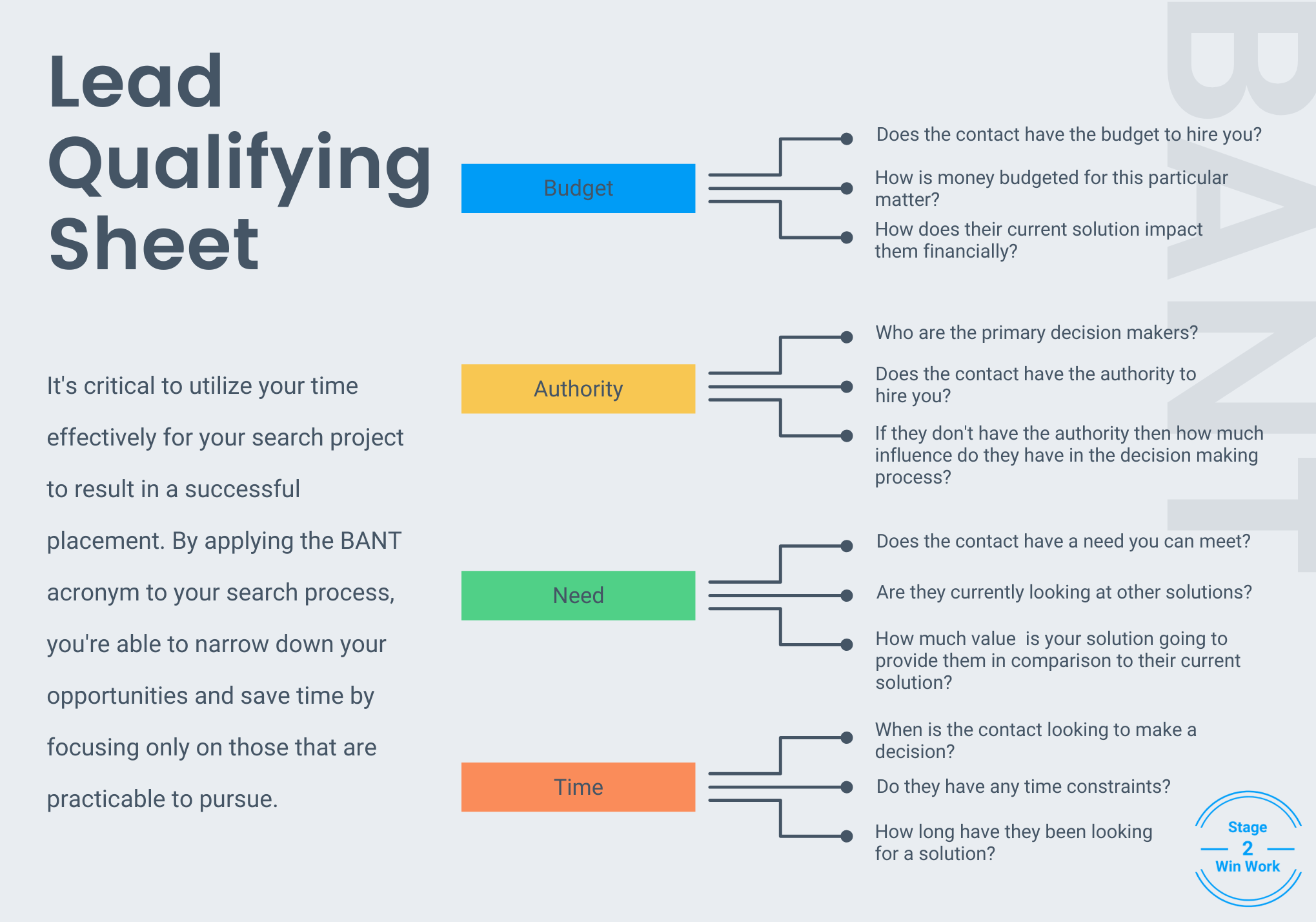Executive Recruiting Best Practices: Winning New Work for Your Executive Search Firm

In our last article “Best Practices For Marketing Your Executive Search Firm” we discussed how to leverage your executive search specialization to find new executive search work. By completing the Specialization Worksheet and Targeted Marketing Worksheets you have generated a list of prospects and companies to target using SEO, paid social media campaigns and digital marketing channels. Now that you have set these marketing plans into action, or partnered with a marketing expert, new leads will begin to come through your website and fill your sales pipeline. When a prospective lead hits your inbox your next steps will be to:
- Score And Gauge Fit For Whether A Lead Is Qualified
- Customize And Prepare Your Pitch Deck For Presentation
- Determine If You Should Refer A Search To Another Firm
Score and Evaluate New Executive Search Leads
When a new lead enters your pipeline, you will need to do some research to determine if the contact request or inquiry is qualified and aligned with your executive search services. This helps you focus your energy and time on pursuing relevant leads. Use the Lead Qualifying Worksheet to help you understand how to manage incoming leads and prioritize your time. The Lead Qualifying Worksheet follows the BANT process for assessing leads based upon budget, authority, need and time. Some of the answers to these questions you can find on your own and others you will need to surface during discovery and exploratory calls with the potential client.
Budget
To qualify a lead it’s important to understand budgets for several reasons and know what other investments have already been made into an executive placement. This will help you understand the challenges a prospect has already faced. For example, sometimes a company will attempt to conduct an executive search assignment in-house first and become frustrated with the results or quality of the candidates. In other cases, budgets may have been spent working with a different executive search firm, but the search failed.
In addition, it is important that a discussion takes place early in the exploratory phase surrounding your search fee, the retainer model for executive search and what a prospect can expect to pay. Being transparent about cost at the beginning of the process will save you and your prospect time and can allow for any internal discussions that need to happen earlier and assure that you are both aligned from the onset of what the cost is for an executive search.
Authority
Often a Hiring Manager or Decision Maker will delegate shortlisting and finding a qualified executive search firm to a junior member of their team. If a lead comes through with a junior employee listed as the primary contact, do some research about who this person is and what influencers, stakeholders and decision makers they will report to at the organization.
Determine who you should be speaking with and who has the power and authority to make a decision about retaining your executive search firm. Prospective lead contacts are primarily the gatekeepers who manage access and flow of information to influential hiring decision makers. Maintaining a healthy and respectful rapport with these gatekeepers is just as important as managing relationships with higher level decision makers.
Need
After you have determined the available budget and identified the right authority figures, you need to understand what their talent requirements and needs are. More often than not, there is a general lack of understanding between the fundamental differences for executive search and typical staffing engagements. It is important to identify whether the prospective client will need your executive search services or a different type of recruitment solution. Here are some questions to consider in order to determine if your service offering aligns with a prospect’s talent needs:
- Within the organization structure, where will the executive key hire sit? Is it truly a senior level position?
- What is their current solution for executive search and executive level placements?
- Can you actually add more value to their process?
- Are they looking at other executive search firms? If so, what type of search work do these other firms do?
- Will they need other senior executives to build their leadership team?
Timing
Once you have determined that there is a need for your executive search services you must explore timing and manage these expectations. Timing will need to be evaluated at multiple layers prior to pitching and engaging a prospect for an executive search. Speak to your prospective client about timing to discover their own internal timelines for choosing a search firm, starting a search and when they want a senior executive placed. It is critical to gauge whether or not these expectations are realistic and aligned with your own process.
On the other hand, it is critical to take a look at your own availability and internal resources. Ask yourself whether you have the bandwidth to take on a new search project. Can you devote enough resources and time to this prospective client’s search to be successful and make them happy? Be mindful of this when dealing with prospects and setting up a search and your team for success. Overpromising and under delivering is something that you cannot afford to risk in an executive search. The success of your executive search firm and winning new work is largely dependent upon your reputation and delivering the right candidate on time.
Draft Your Pitch
Once you have gone through the Lead Qualifying Worksheet and determined there is a fit between your specialization and a prospect, now is the time to develop your pitch deck. Here is an example pitch deck for an executive search firm.
Many search firms fall into the trap of recycling their pitch decks from prior client pitches and executive search projects. This is a common mistake and will hurt your chances for winning a search. Remember that no two executive search projects are the same and this should be true of your pitch as well.
Take the time to carefully review your pitch deck and assure that all of your metrics, placement rates, days to placement and client references are updated and correct. Customize your pitch deck to include searches you have worked on in the past that are relatively similar to the search that your prospective client needs done. Personalize your pitch by including your prospective client’s logo, branding and details directly within your pitch deck. They are hiring you to represent them, their company, and their brand. Personalization of your pitch deck demonstrates you understand the significance, creates a connection with the prospect and will visually communicate that you have put significant time and effort into developing an in-depth, detailed strategy for their talent needs.
7 Common Mistakes Found in Pitch Decks
- Wrong Client Name Or Logo
- Incorrect Or No Contact Details For You Or Your Search Firm
- Prior Search Work Is Not Updated Or Is Irrelevant To The Search You Are Pitching
- Value That You Add Is Not Clearly Defined
- There Is No Clear Step-By-Step Explanation Of Your Process
- Timelines And Expectations Are Not Precise
- Spelling Errors
In your pitch it is critical to hit upon the key things a prospect needs to know about your search firm, why you are an expert and why they should choose you. This illustrates the who, what, where, when and why your executive search firm is the best in its speciality and how you can help your clients.
Your pitch deck is the first touchpoint that a prospective client will have with you. This first impression can make or break winning the search, and prospects will unknowingly seek out errors for scrutinization. Your pitch deck is one of the few materials that you will leave behind after a meeting for a prospect to reference and review for later. Everything within your pitch deck must be accurate, factual, complete and explanatory.
When There Isn’t a Fit - Refer a Search
At the end of the day, your time is valuable. Sometimes there is not a fit between a prospective client and your search firm or you just don’t have the bandwidth to take on a new client - and that’s OK. Other times an existing client may come to you with a search project that is beyond your specialization and expertise.
Taking on work outside of your specialization is a risk for several reasons. Without access to the right talent pools and established relationships with candidates and sources, your search will take much longer, your placement rate will suffer and you can damage your reputation. Taking on a search without the proper knowledge, understanding or experience of an industry, will ultimately be a disservice to a prospect or client and possibly jeopardize the relationship.
Instead of turning a prospective client away and forfeiting potential revenue, maintain your role as a trusted advisor and pass or refer the search project to another search firm that has the right experience. Executive search firms often have standard referral agreements set in place that will pay a small percentage of the total search fee, as a Finder’s Fee, to the other search firm for passing and referring the work to them. You can capitalize on the time you have already spent by building the relationship and receive a portion of the ~$60,000 search fee simply by referring the work. In your client’s or prospect’s eyes, they will be happy you could still provide a solution to their talent challenges even if you are unable to manage the search.
If you already know someone that you can refer a search to, that’s great! However, sometimes a prospect or a client will present you with a search that isn’t a fit for you or anyone else you know. In that case you can refer a search through the Clockwork Network. The Clockwork Network has hundreds of search firms that specialize in many niche areas. We work to find, match and introduce you to the right executive search consultant with the right specialization that can successfully complete the search.
Having a software system like Clockwork is critical for pitching and winning more executive search work. Clockwork’s filters make it easy to find relevant past search projects and candidates to highlight in your pitch. Clockwork’s powerful deals tools allow you to see where a deal is in the pipeline, easily add notes and generate powerful reports to analyze your won and lost deals over time.
The Lead Qualifying Worksheet and Example Pitch Deck in this article are from Clockwork’s free online course on The Eight Stages of Successful Retained Search. Register today for many more examples and best practices.
The Eight Stages of Successful Retained Search
- Intro to the Eight Stages of Successful Retained Search
- A.I.'s Future Impact On The Executive Search Process
- Search Firms Are Divided If A.I. Can Intelligently Source and Assess Finalist Candidates
- Search Firms Believe A.I. Will Have Little Impact On Final Stages Of A Search.
- Search Firms See A.I. Supplementing Most Of Their Marketing Efforts
To learn how The 8 Stages of Successful Retained Search are incorporated and supported in Clockwork, read our support documentation. To see it in action, view this playlist of videos.
Thaddeus Andres
With nearly 13 years of experience within executive search and recruitment, Thaddeus has held several marketing roles at various industry associations, networks and companies where he was responsible for implementing, leading and driving key marketing strategies and initiatives.


